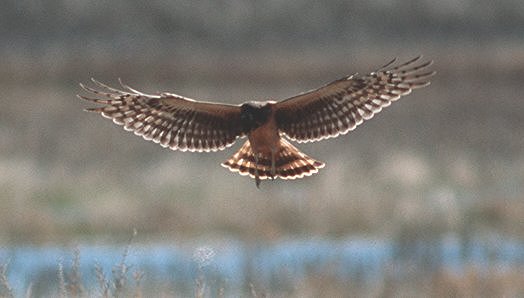|
Northern Harrier Circus cyaneus Aguilucho Pálido,
|
 |
|
Photo: S. Bentsen
|
|
Northern Harrier Circus cyaneus Aguilucho Pálido,
|
 |
|
Photo: S. Bentsen
|
|
IDENTIFICATION: A long-winged hawk with a white rump patch. The males are gray above with a black wing tip, while the females are brown. Length: 46-61 cm.; weight: males 370 g., females 546 g. VOICE: On the breeding grounds, makes a series of "kek" notes. In winter makes a series of descending, high-pitched notes "eeyah". Audio (M. Oberle). HABITAT: Coastal lowlands, fields and marshes in Puerto Rico. HABITS: This species often holds its wings in a V-profile as it glides low over grasslands or marshes searching for rodents and small birds. It uses hearing as well as sight to locate prey. On its breeding grounds in North America, males will sometimes have more than one mate (up to 5 in one season), especially if rodents are plentiful at the beginning of the breeding season. The male starts construction of a hidden, ground nest, and the female completes the job, or sometimes builds a new nest nearby. She lays 3-5 eggs. The female does all the incubation and brooding, while the male supplies most of the food for her and the nestlings. The male will often pass the food to the female in mid-air. Incubation period is 30-32 days, and the chicks walk around on the ground near the nest after 2 weeks. They fledge 28-33 days after hatching. STATUS AND CONSERVATION: An uncommon winter visitor to Puerto Rico. RANGE: Breeds from Alaska to the Maritime provinces of Canada, south to the middle Atlantic states, California and northwestern Mexico. Winters from the northern USA to Panama, and in Cuba, the Bahamas and less commonly Hispaniola and Puerto Rico. Reported in recent years in Puerto Rico from Caño Tiburones (e.g., 15 de diciembre 1999) and Laguna Cartagena. TAXONOMY: FALCONIFORMES; ACCIPITRIDAE; Accipitrinae. Formerly called Marsh Hawk. |
|
 |
|
|
Photo: S. Bentsen
|
 |
|
|
Photo: S. Bentsen
|
 |
|
|
Photo: G. Beaton
|
|
References Arendt, W.J. 1992. Status of North American migrant landbirds in the Caribbean region: a summary. Pp. 143-171 in Ecology and conservation of neotropical migrant landbirds (J.M. Hagan III and D.W. Johnston, eds.) Smithsonian Instit. Press, Washington, D.C. del Hoyo, J., A. Elliott, and J. Sargatal, eds. 1994. Handbook of Birds of the World, Vol. 2, New World vultures to guineafowl. Lynx Edicions, Barcelona. Ehrlich, P.R., D.S. Dobkin, and D. Wheye. 1988. The birder’s handbook: a field guide to the natural history of North American birds. Simon and Schuster/Fireside, NY. Johnsgard, P.A. 1990. Hawks, eagles, and falcons of North America: Biology and natural history. Smithsonian Institution Press. Washington, DC. MacWhirter, R. B., and K. L. Bildstein. 1996. Northern Harrier (Circus cyaneus). No. 210 in The birds of North America (A. Poole and F. Gill, eds.). Acad. Nat. Sci., Philadelphia, PA, and Am. Ornithol. Union, Washington, D.C. Raffaele, H.A. 1989. A guide to the birds of Puerto Rico and the Virgin Islands. Princeton. Raffaele, H.A. 1989. Una guía a las aves de Puerto Rico y las Islas Vírgenes. Publishing Resources, Inc., Santurce, PR. Raffaele, H.A., J.W. Wiley, O.H. Garrido, A.R. Keith, and J.I. Raffaele. 1998. Guide to the birds of the West Indies. Princeton. Rivera-Milán, F.F. 1995. Distribution and abundance of raptors in Puerto Rico. Wilson Bull. 107(3):452-462. Scholz, F. 1993. Birds of prey. Stackpole Books, Mechanicsburg, PA. Raptors in general in Puerto Rico: http://netdial.caribe.net/~falconpr/ Northern Harrier, Spanish text Next related species in taxonomic order Previous related species in taxonomic order |
|